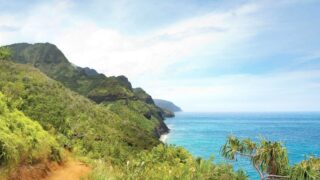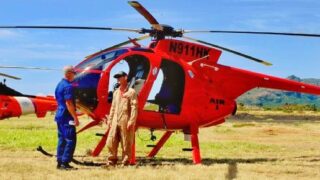A hiker who began the Kalalau Trail with a pre-existing ankle injury was air rescued on Wednesday and then refused medical care, igniting one of the sharpest reactions we have seen on Kauai in a long time. People were not upset about the rescue itself, which is common on this trail. They were reacting to the belief that the entire situation was avoidable.
The hiker was a Hawaii resident visiting from Oahu who started Kalalau already injured, called for help when the hike became too difficult, walked to the helicopter without assistance, and then declined treatment once evacuated to Princeville. The feeling across Kauai was that this crossed a line at a time when residents had grown weary of preventable rescues, whether involving visitors or local residents.
This comes after repeated warnings from county officials that some calls may no longer qualify as emergencies. We wrote about that in Hiker Rescues In Hawaii: When Will You Have To Pay?, where Kauai made clear that fatigue is not automatically considered a valid reason for rescue. This case, where the injury existed before she even stepped onto the trail, pushed that conversation into new territory.
How the Kalalau rescue unfolded.
According to the county, the 40 year old Oahu woman texted 911 around nine in the morning. She reported that her pre-existing ankle injury prevented her from hiking out. Air 1 launched from Lihue, located her near the red hill landing zone, and found her ambulatory and able to walk without assistance. She was escorted into the helicopter, flown to Princeville Airport, turned over to paramedics, and then refused medical care. The operation wrapped up shortly after eleven.
We have seen many Kalalau rescues this year caused by heat, terrain, and poor decisions. That included the heat-driven rescues described in As Hawaii Bakes Heat Illness Triggers New Kalalau Trail Rescues and ankle injuries covered in This Kauai Trail Looks Easy Until The Rescue Chopper Arrives. Those incidents involved hikers who were caught by the trail. This one involved someone who arrived already compromised.
Kauai’s reaction was immediate and sharp.
The Facebook comments were blistering. One resident wrote, “Probably not a trail you should attempt if you have preexisting injury.” Another said, “She just wanted a ride out.” A third asked, “Why would one go in anyway with a pre-existing ankle injury?”
One Kauai resident said, “It isn’t just their life on the line, it’s the lives of first responders too,” which became a central theme. Several questioned how someone could be too injured to hike out but still able to walk to the helicopter and refuse care on the other end.
Others said this pattern has changed dramatically. One wrote that it seems to happen “every week,” while another said “ten years ago, only real emergencies called for help.” The phrase “Air Uber” came up several times, reflecting frustration that some hikers appear to treat Air 1 as an escape option rather than an emergency tool, and the anger echoed broader complaints we heard in Kauai Residents Speak Out: Tourism’s Impact On Daily Life, where residents said they feel increasingly squeezed by visitor-driven strain on county resources.


Cost comparisons also resonated. A resident commented, “An ambulance ride from Poipu to Wilcox Hospital costs about $2500,” a point repeated throughout the thread. The contrast made people question how the most dangerous, expensive rescue option remains the easiest to summon.
One commenter even claimed that online videos encourage hikers to exploit the system, saying there are “viral videos on TikTok teaching people how to do this.” Whether true or not, the fact that people even believe it shows how raw the issue has become.
Hawaii’s policy failure at the center of the anger.
Much of the frustration shifted from the hiker to county policy. Kauai already has a mechanism designed for precisely this scenario. Bill 2910 allows the county to recover rescue costs exceeding $1,000 when someone acts with “intentional disregard for safety” or ignores warnings. Several residents quoted the bill directly and asked why it has never been used.
We covered the statewide version of this discussion in Hawaii’s plans to make visitors pay for rescues continue, where officials debated when a bill should follow a rescue. What makes this case stand out is how clearly it fits the scenario described by Bill 2910: a hiker with a known limitation entering a trail where that limitation makes rescue predictable.
The deeper tension on Kalalau.
Kalalau remains one of Hawaii’s most stunning and treacherous trails. It demands a strong footing, endurance, and respect. When sudden injuries or heat illnesses occur, the community supports rescue without hesitation. We wrote in Who Gets Rescued In Hawaii The Answer Will Surprise You that locals and visitors contribute almost equally to rescue totals.
But this case hit differently. The injury existed before the trail. The outcome that triggered a viral response felt expected. And the refusal of treatment made it look avoidable. Residents felt their patience was being tested by situations that place real risk on pilots, rescue crews, and firefighters.
What Kauai may do next.
Some residents called for the enforcement of Bill 2910. Others suggested requiring hikers to sign waivers acknowledging the costs of rescue. A few want mandatory ambulance transport after any Air 1 extraction, ensuring that a bill inevitably follows. Some proposed stronger warnings or restrictions for those with pre-existing conditions.
What feels clear is the growing gap between the seriousness of Kalalau rescues and the preparation some hikers bring to the trail. First responders will always prioritize safety, but many on Kauai now believe too many calls result from preventable situations that put crews at risk.
Where do you think the line should be drawn for when hikers should be charged for a rescue, especially when the injury or limitation existed before the hike even began?
Get Breaking Hawaii Travel News







My wife and I hiked to Hanakapiai Falls on July 27th. A hiker a few minutes ahead of us, maybe 500 meters from the falls, broke her ankle and was airlifted out. A doctor and his family near us stopped and really helped stabilize that woman and splint her to help move her for the airlift while we tried to get through on satellite. Watching the whole thing first hand, those rescues are no joke. Narrow canyons, dense foliage, personnel dropping onto outcroppings right next to the stream.
The county should 100% implement an agreement when passes are purchased that requires medical evaluation in the event of an airlift and a fixed charge in the $000s if the evaluation determines the evacuation was non-emergency. This is getting ridiculous and people need to be responsible – just like the ocean, if in doubt, don’t go out.
That woman should be charged $$$$ with the entire rescue that she initiated. She made the conscious decision to walk a very treacherous trail so pay the piper……….i am very happy no one else needed the services of the air rescue helicopter when she abused the service.
I think many people who go on this trail have varying amounts of pre-existing medical conditions. Some have been cleared for exercise and encouraged by their doctors to participate in moderate exercise. Payment required should be a case by case decision. All air lifted should be required medical evaluation afterwards. For non-residents this information and agreement could go into the reservation process.
It’s an understandably tricky situation. Now that visitors need to book and pay for a pass, many people feel more committed to going ahead with their hike even when the weather turns wet or the track becomes muddy and less safe. Because the pass is paid for and the date often cannot be changed, it can feel like there’s no choice but to continue with the day and trek even if not ideal. At the same time, the fact that the park now charges a fee can create the impression that hikers are entitled to a certain level of support or service as part of what they have paid for, which may lessen any sense of hesitation about calling for help when something goes wrong. I am not in agreement and believe people should pay/contribute at minimum for the expense but am it is important to see how this may be perceived perhaps?
The line should be drawn straight to the wallet of the one who is being rescued. This unnecessary rescue for this entitled person really is disgusting. Maybe this trail should finally be closed. Some people just have no respect for the aina and rescue personnel and it shows.
This is just ridiculous! This 40-year-old female hiker is an absolute arrogant elitist entitlement selfish narcissist who cares nothing about the public good. Anyone so stupid to attempt the Kalalau Trail with an ankle injury should be responsible for the entire cost of the air rescue. It’s time for the county of Kauai to get serious about people who are abusing the First Responders in these ever increasing rescue missions brought on by mindless thoughtless idiot outdoor adventurers.
“Book em Dano!”
The Kalalau Trail is inherently dangerous. There needs to be a strongly worded message at the entrance. Not to proceed without proper gear and a healthy strong body. There needs to be a clear warning that emergency extractions are billable in cases of gross negligence, such as proceeding despite pre-existing injury or physical or mental limitation. All extracted will be flown to medical centers for evaluation and medical clearance. By proceeding beyond the entrance all hikers assume the risk of injury and full payment for emergency services. Proceed at your own risk.
Not the place to test your new hiking shoes or your knee replacement. Not the time to get high or learn about your fear of heights. But it is a great time to test your respect for untamed Nature, to feed your soul, and grow your spirit of survival.
Send her to the cleaners. One to clean up her back account, another to clean up her act and another to clean up her mind. That’ll teach her, hopefully.
Simple solution!
Hawaii state residents are entitled to free access to all Hawaii recreation sites and rescues with no fees and no resevations needed.
The Governor can add another $100 tourist “Illegal Extortion Fee”.
If Air1 does not already have cameras for various safety and operational purposes, they should install them immediately. Especially in the patient compartment for monitoring and externally for situational awareness for pilots and ground crews. The external cameras can also record how patients are loaded into Air1 and the patient compartment would catch conversations such as “my pre-existing ankle injury prevented me from hiking out.” Both can be used later to prove cases of fraudulent request for service. All calls should be billed regardless of the severity of injury. The insurance and patient can figure out who pays and if the service was medically necessary.
This woman is a state resident which means she got to enter the park for free. Then with a pre-existing condition she gets a free, and very expensive, ride out? Did she do this with others or solo? Some cases may fit in a gray area, but this one is clear, a bill needs to be sent.
You call a taxi, expect to pay. Unless you are having a heart attack (or similar) or are not ambulatory, Air 1 needs to stay on the ground.
I’m sure there are a few tourist chopper outfits that would like to be part of a “tow truck” rotation for non-emergency evacuations that get charged a fixed (say $5k) amount.
Then you can argue it with your insurance (who will point out the exclusion in your policy).